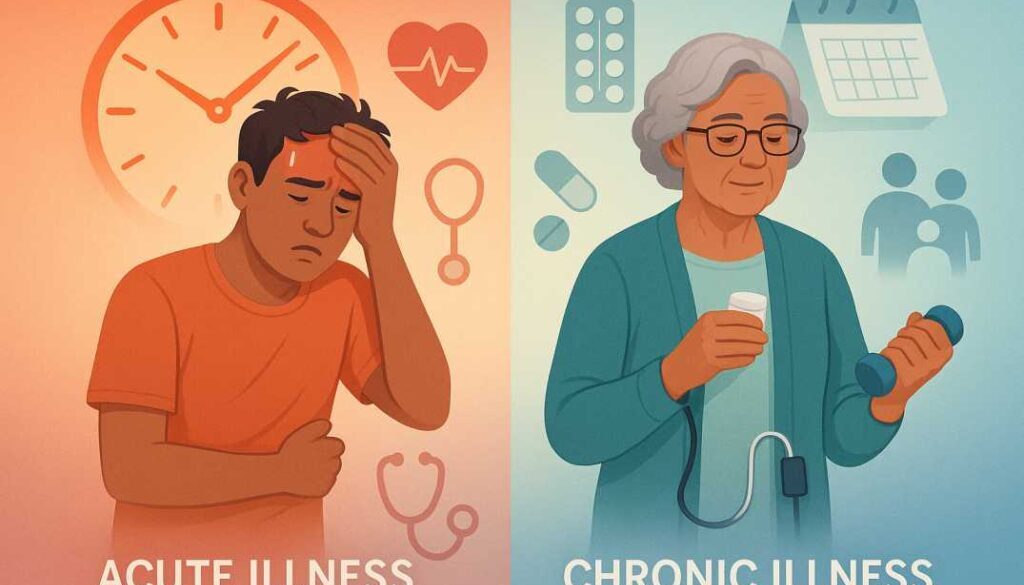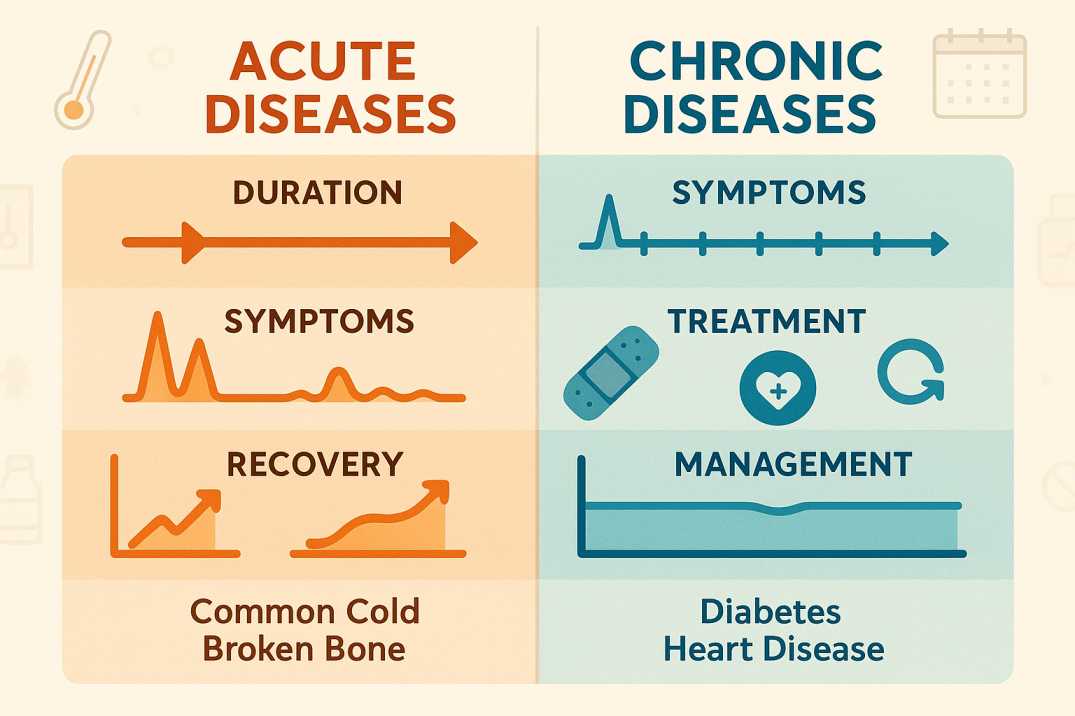Acute vs Chronic Disease: Key Differences & When to Seek Care
Understanding the difference between acute and chronic diseases is crucial for making informed healthcare decisions and managing your family’s health effectively. Whether you’re dealing with a sudden illness or managing a long-term condition, knowing these distinctions can help you seek appropriate care and develop better health strategies.
Understanding Disease Classification: Acute vs Chronic Disease
Healthcare professionals classify medical conditions based on their onset, duration, and treatment requirements. This classification system helps doctors determine the most appropriate care approach and helps patients understand what to expect from their condition.
Bottom Line Up Front: Acute diseases develop suddenly and typically resolve within days to weeks with proper treatment, while chronic diseases develop gradually and require ongoing management for months, years, or a lifetime.
What Are Acute Diseases?
An acute disease is a medical condition that develops suddenly, progresses rapidly, and typically lasts for a short period. These conditions often have a clear beginning and end, with symptoms that appear quickly and may be severe in the short term.
Key Characteristics of Acute Diseases
- Sudden onset: Symptoms appear rapidly, sometimes within hours or days
- Short duration: Most acute conditions resolve within a few days to several weeks
- Rapid progression: Symptoms often escalate quickly, requiring prompt attention
- Definitive treatment: Many acute diseases have specific treatments that can cure or resolve the condition
- Full recovery potential: Most people return to their normal health status after treatment
Common Examples of Acute Diseases
Infectious Conditions:
- Common cold and influenza
- Strep throat and pneumonia
- Food poisoning and gastroenteritis
- Urinary tract infections
Injuries and Emergencies:
- Broken bones and fractures
- Burns and cuts
- Heart attacks and strokes
- Appendicitis and gallbladder attacks
Other Acute Conditions:
- Asthma attacks (acute episodes of chronic asthma)
- Allergic reactions
- Migraine headaches
- Acute kidney failure
Acute Disease Symptoms
Acute disease symptoms typically include:
- High fever and chills
- Severe pain or discomfort
- Sudden weakness or fatigue
- Nausea and vomiting
- Difficulty breathing
- Rapid changes in vital signs
What Are Chronic Diseases?
A chronic disease is a medical condition that develops gradually over time and persists for an extended period, often requiring ongoing medical management throughout a person’s life. These conditions typically cannot be cured but can be controlled with proper treatment.
Key Characteristics of Chronic Diseases
- Gradual onset: Symptoms develop slowly, sometimes over months or years
- Long duration: Conditions persist for more than three months and often for a lifetime
- Progressive nature: Many chronic diseases worsen over time without proper management
- Ongoing management: Requires continuous treatment and lifestyle modifications
- System-wide impact: Often affects multiple body systems and organs
Common Examples of Chronic Diseases
Cardiovascular Conditions:
- Heart disease and high blood pressure
- Chronic heart failure
- Coronary artery disease
Metabolic Disorders:
- Type 1 and Type 2 diabetes
- Thyroid disorders
- Obesity
Respiratory Conditions:
- Chronic obstructive pulmonary disease (COPD)
- Asthma (chronic form)
- Sleep apnea
Musculoskeletal Disorders:
- Arthritis and osteoporosis
- Chronic back pain
- Fibromyalgia
Neurological Conditions:
- Alzheimer’s disease and dementia
- Multiple sclerosis
- Parkinson’s disease
Eye-Related Chronic Conditions:
- Glaucoma and macular degeneration
- Diabetic retinopathy
- Cataracts
Chronic Disease Symptoms
Chronic disease symptoms often include:
- Persistent fatigue and weakness
- Ongoing pain or discomfort
- Gradual functional decline
- Mood changes and depression
- Sleep disturbances
- Mild symptoms that worsen over time
Key Differences Between Acute and Chronic Diseases
| Aspect | Acute Diseases | Chronic Diseases |
|---|---|---|
| Onset | Sudden, rapid development | Gradual, slow progression |
| Duration | Days to weeks | Months to lifetime |
| Symptoms | Severe, distinct, rapid changes | Mild to moderate, persistent |
| Treatment | Short-term, often curative | Long-term management |
| Recovery | Complete recovery expected | Ongoing control, not cure |
| Impact | Temporary disruption | Lifestyle adjustment required |
| Examples | Flu, broken bone, pneumonia | Diabetes, arthritis, heart disease |
Causes and Risk Factors
Acute Disease Causes
Acute diseases typically result from:
- Infectious agents: Viruses, bacteria, fungi, causing acute illness
- Injuries: Accidents, falls, sports injuries, causing acute trauma
- Environmental factors: Toxic exposures, extreme temperatures, causing acute reactions
- Sudden organ dysfunction: Heart attacks, strokes, kidney failure (acute events)
- Allergic reactions: Food allergies, medication reactions (acute immune responses)
Chronic Disease Causes
Chronic disease often develops due to:
- Lifestyle factors: Poor diet, lack of exercise, and smoking contribute to chronic disease
- Genetic predisposition: Family history and inherited chronic disease conditions
- Environmental factors: Air pollution, occupational hazards leading to chronic disease
- Age-related changes: Natural aging process and chronic disease development
- Previous acute conditions: Some acute diseases can lead to chronic disease complications
Diagnosis and Treatment Approaches
Diagnosing Acute Diseases
Healthcare providers typically diagnose acute conditions through:
- Rapid assessment: Quick physical examination and symptom evaluation
- Point-of-care testing: Immediate diagnostic tests like rapid strep tests or X-rays
- Laboratory tests: Blood work, urinalysis, or cultures when needed
- Imaging studies: CT scans, MRIs, or ultrasounds for emergencies
Diagnosing Chronic Diseases
Chronic disease diagnosis often involves:
- Comprehensive evaluation: Detailed medical history and extensive physical examination
- Multiple tests over time: Repeated lab work to track disease progression
- Specialized testing: Advanced imaging, biopsies, or specialist consultations
- Monitoring periods: Observing symptoms and test results over months
Treatment Differences
Acute Disease Treatment:
- Immediate intervention to address symptoms
- Short-term medications (antibiotics, pain relievers)
- Surgical procedure, when necessary
- Rest and supportive care
- Goal: Complete cure or resolution
Chronic Disease Treatment:
- Long-term management strategies
- Ongoing medications and therapy
- Lifestyle modifications (diet, exercise, stress management)
- Regular monitoring and adjustments
- Goal: Control symptoms and prevent complications
Impact on Daily Life and Family Health
Living with Acute Diseases
While acute diseases can be disruptive, they typically:
- Require temporary lifestyle adjustments
- May need a brief time off work or school
- Cause short-term financial impact
- Resolve with appropriate treatment
- Allow return to normal activities
Managing Chronic Diseases
Chronic conditions require:
- Ongoing lifestyle adaptations: Diet changes, exercise routines, medication schedules
- Family involvement: Support from family members for management
- Financial planning: Long-term healthcare costs and insurance considerations
- Emotional support: Counseling and support groups
- Regular healthcare visits: Consistent monitoring and preventive care
Prevention Strategies
Preventing Acute Diseases
- Good hygiene: Regular handwashing and sanitization
- Vaccination: Stay current with recommended vaccines
- Safety measures: Use protective equipment, follow safety guidelines
- Healthy lifestyle: Maintain a strong immune system through proper nutrition and exercise
- Prompt treatment: Seek early care for symptoms to prevent complications
Preventing Chronic Diseases
- Healthy diet: Focus on whole foods, limit processed foods, and added sugars
- Regular exercise: Aim for at least 150 minutes of moderate activity weekly
- Avoid tobacco: Don’t smoke and avoid secondhand smoke exposure
- Limit alcohol: Moderate consumption or abstinence
- Manage stress: Practice relaxation techniques and maintain work-life balance
- Regular screenings: Early detection through preventive healthcare visits
When to Seek Medical Care
Acute Disease Warning Signs
Seek immediate medical attention for:
- High fever (over 103°F)
- Severe chest pain or difficulty breathing
- Signs of stroke (sudden weakness, speech problems)
- Severe abdominal pain
- Uncontrolled bleeding
- Loss of consciousness
Chronic Disease Management
Regular medical care is essential for:
- Routine monitoring appointments
- Medication adjustments
- Preventive screenings
- Managing complications
- Coordinating care between specialists
The Role of Healthcare Partners
Managing both acute and chronic conditions requires establishing strong relationships with healthcare providers who understand your family’s unique needs. Look for healthcare practices that offer:
- Comprehensive care for all ages
- Experience with both acute emergencies and chronic disease management
- Accessibility for urgent concerns
- Patient education and support
- Coordinated care with specialists when needed
Recent Research and Developments
Global Burden of Disease Insights
Recent research from the Global Burden of Disease Study 2019 reveals that approximately 68% of DALYs (Disability-Adjusted Life Years) were attributed to chronic care, while 27% were due to acute care globally. This data highlights the growing importance of chronic disease management in healthcare systems worldwide.
Emerging Treatment Approaches
Recent studies have shown promising developments in:
- Personalized medicine: Genetic testing to tailor chronic disease treatments
- Remote monitoring: Technology-enabled chronic disease management
- Preventive interventions: Early detection strategies for chronic conditions
- Integrated care models: Coordinated approaches combining acute and chronic care
Inflammation Research
New research on chronic inflammation explores potential treatments for chronic diseases and cancer, suggesting that chronic inflammation may have different origins than acute inflammation, which could lead to more targeted treatment approaches in the future.
References and Evidence Base
This clinical review is founded upon current medical research and authoritative health sources. The following evidence-based resources provide additional clinical information for healthcare professionals and patients seeking a comprehensive understanding:
Primary Research Citations
-
Global Burden of Disease Collaborative Network (2025)
- “Characterising acute and chronic care needs: insights from the Global Burden of Disease Study 2019”
- Nature Communications, Published: May 2025
- Clinical Finding: 68% of global DALYs are attributed to chronic care versus 27% to acute care requirements
- DOI Access: https://www.nature.com/articles/s41467-025-56910-x
-
Centers for Disease Control and Prevention (2025)
- “About Chronic Diseases: Prevalence, Costs, and Prevention”
- Updated: July 2025
- Epidemiological Finding: 60% of American adults have at least one chronic disease; 90% of $4.9 trillion healthcare expenditure
- Official Access: https://www.cdc.gov/chronic-disease/about/index.html
-
CDC Behavioral Risk Factor Surveillance System (2025)
- “Trends in Multiple Chronic Conditions Among US Adults, By Life Stage, 2013–2023”
- Preventing Chronic Disease Journal, Published: 2025
- Longitudinal Finding: 76.4% of US adults have one or more chronic conditions, with increasing prevalence in younger demographics
- Research Access: https://www.cdc.gov/pcd/issues/2025/24_0539.htm
Additional Clinical Resources
- CDC Physical Activity Guidelines for Americans (2025): Evidence-based exercise recommendations for chronic disease prevention
- American Heart Association Scientific Statements: Comprehensive cardiovascular health guidelines and research
- National Institutes of Health Clinical Resources: Research-based health information and prevention protocols
Conclusion: Understanding Your Health Journey
The distinction between acute and chronic diseases isn’t just academic—it’s fundamental to making informed healthcare decisions for you and your family. Acute diseases, while often more dramatic in their presentation, typically resolve with appropriate treatment. Chronic diseases, though they develop more gradually, require ongoing attention and management strategies.
Key Takeaways:
- Acute diseases require immediate attention, but often resolve completely
- Chronic diseases need long-term management, but can be controlled effectively
- Prevention strategies differ for each type of condition
- Healthcare partnerships are essential for managing both acute episodes and chronic conditions
- Early intervention can prevent acute conditions from becoming chronic
Understanding these differences empowers you to:
- Recognize when to seek immediate medical care
- Develop appropriate long-term health strategies
- Make informed decisions about preventive care
- Build strong relationships with healthcare providers
- Take an active role in your family’s health management
Whether you’re dealing with a sudden illness or managing a long-term condition, remember that effective healthcare is a partnership between you and your medical team. By understanding the nature of your condition and working closely with experienced healthcare providers, you can achieve the best possible outcomes for your health and quality of life.
Ready to take control of your family’s eye health? Contact Poudre Valley Eyecare in Fort Collins to schedule comprehensive eye exams for your family. Our caring team provides personalized attention and accepts most insurance plans, including Medicare and Medicaid. Call us today to become part of our extended family of patients who have trusted us for over 25 years.
FAQs
-
Acute diseases appear suddenly and last days to weeks, while chronic diseases develop gradually and persist for months, years, or a lifetime.
Please note: None of the above should be considered medical advice. If you’re having any concerns about your vision, please reach out to us immediately or see your primary care provider.




